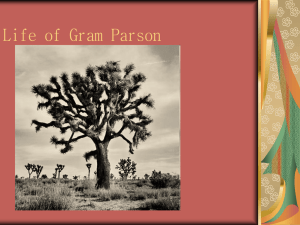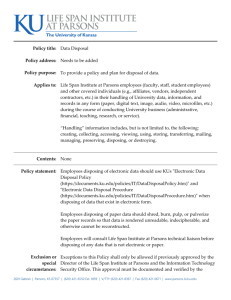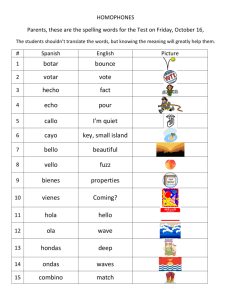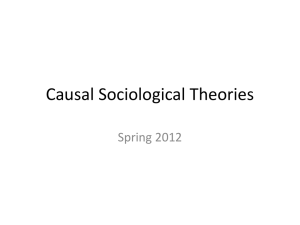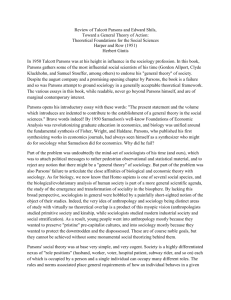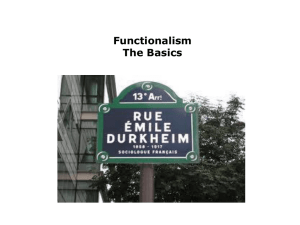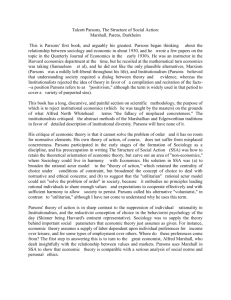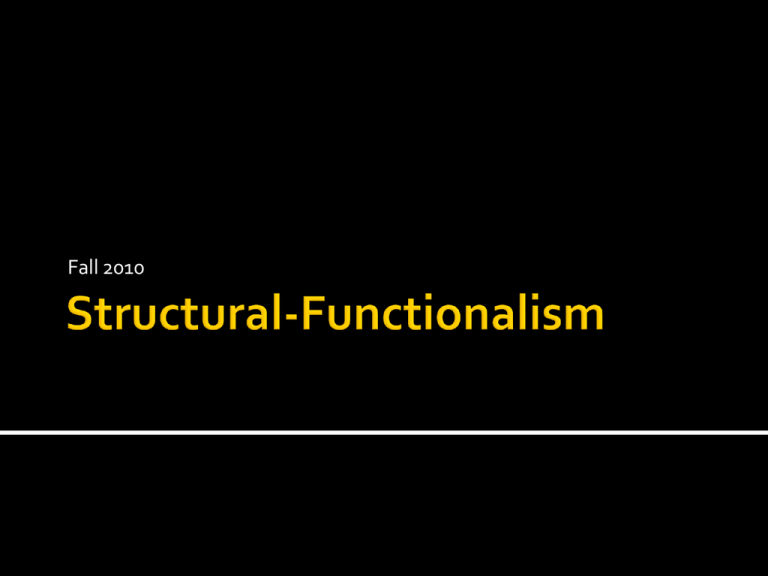
Fall 2010
Greeks (Aristotle)
Hobbes & Rousseau
Darwin
Comte
Marx
Wundt
Spencer
Freud
Pareto
Weber
Durkheim
Malinowski
Radcliffe-Brown
Parsons
(1938)
Merton
Conflict Theory
Critical Theory
Coser
(1962)
Parsons
(1951)
Functionalism: "mode of analysis concerned
with interrelations between social
phenomena in general, and, more
particularly, with the consequences of given
items for the larger structure or structures in
which they are embedded"
(Coser 1976, 146) [after Merton & Stinchcombe].
Functionalism: a theory that explains the
existence and persistence of social practices
in terms of the benefits these practices have
for the system in which they are embedded
Example: Patriotism and patriotic symbols and rhetoric
promote solidarity and willingness to sacrifice for society and
the more of this you get in a society, the better off the society
is.
…don’t pets blow up?
…do people ever stop having sex?
…is it hard to get back on a diet?
…do compliments improve behavior?
…do parties die when a few people leave?
…is there a “monthly cycle”?
Lewis Coser 1962
I.
II.
III.
IV.
Intro
Intra-group Consequences (internal)
Inter-group Consequences (external)
Deviation and Innovation
a) Normative Flexibility and Innovating Roles
b) Time
Lewis Coser 1962
I.
II.
Intro
Intra-group Consequences (internal)
III.
Inter-group Consequences (external)
1) Common mistake – only look inside groups
2) Proscribed, preferred, prescribed
3) Saturnalia: deviant not to deviate
Lewis Coser 1962
I.
II.
Intro
Intra-group Consequences (internal)
1. Oppose deviant, strengthen group
▪
▪
▪
▪
▪
▪
▪
Clarify boundaries – first point out (Gestalt: figure/ground)
Group can see itself in action qua group
Enhance authority of norm
Righteous indignation and identity
Self (& other) examination
Deviance as “fire alarm” (canary in a coal mine)
Rationale for resources
2. Tolerate deviant, strengthen group
▪ Clarify boundaries – last point in (Gestalt: figure/ground)
▪ Group can see itself in action qua group
▪ Expression of group standards or group identity
3. Rigid response to deviance can be dysfunctional
▪ Paranoia and wasted energy in a society of angels…
Eat
+
Time
+
+
Hunger
Satisfaction
-
Interaction
+
+
Guests
+
Time
-
Fun
Stay
+
1.
2.
3.
Society is a system.
Systems have parts…
…that are interrelated.
WHAT IS “INTERRELATED”?
Mutual dependence and Functional requisites
Feedback
▪ Amplification
▪ Attenuation
Social systems need things like
Tools to coordinate behavior
Communication
Generational transmission
Techniques for generating solidarity
Recall Durkheim’s notion of “normal”
1.
Explain practices in terms of system benefits
2.
“Socially” rational vs. individually rational
3.
Systems of functional requisites
Reaction to ethnocentrism and diffusionism*
Cultural context matters
Ethnographic data matters
Need to study societies as “wholes”
* see Baert ch. 2
Level of Needs
Level of Organization
cultural
social
biological
societies
groups
individual
Time Scale
years-generations
months-years
days-months
Everything as functional
There are other reasons practices can survive
Naïve about cohesion as necessary
Unclear concept of system “survival” (or thriving)
How much? What kind?
Toward a “unified theory of society”
Problem: Hobbes’ “problem of order”
Weber:
Greeks (Aristotle)
Hobbes & Rousseau
Darwin
Comte
Marx
Wundt
Spencer
Freud
Pareto
Weber
Durkheim
Malinowski
Radcliffe-Brown
Parsons
(1938)
Merton
Conflict Theory
Critical Theory
1960s
Parsons
(1951)
From Chicago to Harvard
American Journal of Sociology to American
Sociological Review
Crude Dichotomies
Fieldwork to abstract theorizing
People problems to systems problems
Marx’s argument
1. Relative power of classes determined by
a)
b)
c)
Mode of production
Authority system required by that mode
Who owns the productive property
2. Mode changes over time
3. Therefore distribution of power changes
* after Stinchcombe, 1987(1968)
HOW?
1. Power of classes change institutions and
structures.
“The greater the power of a class, the more
effective that class is as a cause of social
structure” (Stinchcombe 1987, 94).
* after Stinchcombe, 1987(1968)
PowerWorkers
PowerBourgeoisie
PowerNobles
ConsequencesNobles
Structure
(Parliamentary
Democracy)
ConsequencesBourgeoisie
ConsequencesWorkers
Consequences of S
Power of Class
Causal Force S
Nobles
-1
5
-5
Bourgeoisie
+1
2
+2
Workers
-1
0
0
Class
Net Causal Force
-3
PowerWorkers
PowerBourgeoisie
PowerNobles
ConsequencesNobles
Structure
(Parliamentary
Democracy)
ConsequencesBourgeoisie
ConsequencesWorkers
…then technology changes, markets expand, factories emerge…
Consequences of S
Power of Class
Causal Force S
Nobles
-1
2
-2
Bourgeoisie
+1
5
+3
Workers
-1
0
0
Class
Net Causal Force
+3
PowerWorkers
PowerBourgeoisie
PowerNobles
ConsequencesNobles
Structure
(Parliamentary
Democracy)
ConsequencesBourgeoisie
ConsequencesWorkers
…then proletariat concentrated in factories, organize, unions, political movements…
Consequences of S
Power of Class
Causal Force S
Nobles
-1
0
0
Bourgeoisie
+1
2
+2
Workers
-1
5
-5
Class
Net Causal Force
-3
PowerWorkers
PowerBourgeoisie
PowerNobles
ConsequencesNobles
Structure
(Parliamentary
Democracy)
ConsequencesBourgeoisie
ConsequencesWorkers
…then proletariat concentrated in factories, organize, unions, political movements…
Education and Work
Amherst. LSE. Heidelberg
Taught at Harvard from 1927
Major Works
1937(8) The Structure of Social Action
1951 The Social System
Contributions
Action Theory
Systems Theory
Unified Theory
AGIL paradigm
Adaptation
System must change in response to environment
Goal Attainment
System needs to get things done, make stuff, achieve)
Integration
Parts of the system need to work together
(L) Pattern maintenance. (L stands for "Latent function")
System must remember and transmit how it does things.
* after Wikipedia, “Talcott Parsons”
The Social system level:
The General Action Level:
The behavioral organism/system.
The personality system.
The social system.
The cultural system.
The cultural level:
The economy — social adaptation to its action and non-action environmental systems
The polity — collective goal attainment
The societal community — the integration of its diverse social components
The fiduciary system — processes that reproduce historical culture in its "direct" social embeddedness.
Cognitive symbolization.
Expressive symbolization.
Moral-evaluative symbolization.
Constitutive symbolization.
Social System level:
(A) Economic system: Money.
(G) Political system: Political power.
(I) The Societal Community: Influence.
(L) The Fiduciary system (cultural tradition): Value-commitment.
* after Wikipedia, “Talcott Parsons”
The Social system level
The General Action Level
The cultural level
The Generalized Symbolic media
Social System level
* after Wikipedia, “Talcott Parsons”
The pure AGIL model for all living systems:
(A) Adaptation.
(G) Goal Attainment.
(I) Integration.
(L) Pattern maintenance. (L stand for "Latent function").
The Social system level:
The economy — social adaptation to its action and non-action environmental systems
The polity — collective goal attainment
The societal community — the integration of its diverse social components
The fiduciary system — processes that function to reproduce historical culture in its "direct" social
embeddedness.
The General Action Level:
The behavioral organism (or system). (In later version, the foci for generalized "intelligence.").
The personality system.
The social system.
The cultural system. (See cultural level).
The cultural level:
Cognitive symbolization.
Expressive symbolization.
Evaluative symbolization. (Sometimes called: moral-evaluative symbolization).
Constitutive symbolization.
The Generalized Symbolic media:
Social System level:
(A) Economic system: Money.
(G) Political system: Political power.
(I) The Societal Community: Influence.
(L) The Fiduciary system (cultural tradition): Value-commitment.
* after Wikipedia, “Talcott Parsons”
Contributions
“Theories of the middle range”
Clarifying functional analysis
Dysfunctions
Unanticipated consequences
Manifest and latent functions
Functional alternatives
Merton's theory of deviance
Sociology of science
Derived from http://en.wikipedia.org/wiki/Robert_K._Merton
Manifest : what we (actors) think the purpose or
consequence of an institution or practice is
Latent : what institution or practice actually does
Institution
Manifest
Latent
antigambling legislation
suppress gambling
create an illegal empire for the organized
crime
Christian missions in Africa
convert Africans to Christianity
Destroy indigenous tribal cultures and provide
impetus towards rapid social change
Dominance of Communist
Party over all sectors of social
life
assure dominance of
revolutionary ethos
created a new class of comfortable
bureaucrats disinclined to the self-denial of
revolution
voluntary associations
America
sociability and public service
Create new status indices for those permitted
to join
from the Wikimedia Commons http://en.wikipedia.org/wiki/File:Mertons_social_strain_theory.svg
Communism – the common ownership of scientific discoveries,
scientists trade intellectual property for recognition and esteem.
Universalism – truth claims evaluated in terms of universal or
impersonal criteria, not on basis of race, class, gender, religion…
Disinterestedness –scientists are rewarded for acting in ways
that outwardly appear to be selfless
Organized Skepticism – all ideas must be tested and subjected
to rigorous, structured community scrutiny.
Emergence of CUDOS = “Merton’sTheory” of the Scientific Revolution
Derived from http://en.wikipedia.org/wiki/Robert_K._Merton

